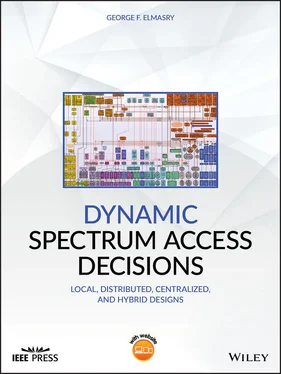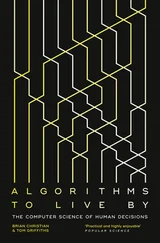19 Wellenhoff, B.H., Lichtenegger, H., and Collins, J., Global positioning system: theory and practice, 4th edition. Springer Verlag, 1997.
20 Reisert, J.H., Understanding and using antenna radiation patterns. Available at: http://www.astronwireless.com/radiation patterns.html, 2007.
21 Elmasry, G.F., Aanderud, B., Kraus, W., and McCabe, R., Software‐defined dynamic power‐control and directional‐reuse protocol for TDMA radios. Proceedings of MILCOM 2015, October 2015, pp.139–144.
22 Roos, T., Myllymaki, P., and Tirri, H., A statistical modeling approach to location estimation. IEEE Transactions on Mobile Computing, vol. 1(1), January/March 2002, pp. 59–69.
1 1 Spread spectrum signals are especially hard to detect with simple energy detection.
2 2 The definitions of false alarm and misdetection depend on the spectrum sensing goal, as clarified later in this chapter.
3 3 As mentioned earlier, the definition of the probability of detection PD and the probability of false alarm PF are case dependent. In the case presented here, PD is the probability of hypothesizing the signal presence where the signal is actually present while PF is the probability of hypothesizing the signal presence but there was only noise power present.
4 4 Notice that using the ROC model for DSA can require considering two main aspects. The first aspect is to estimate the decision threshold λE through analysis. The second aspect is the use of a DSA cognitive algorithm that can fine‐tune the value of λE based on deployment dynamics and design requirements relying on measured metrics.
5 5 It is important to note how the ROC model uses energy instead of signal and noise amplitude sampling. Energy detection uses square values which extends the scale of decision making, leading to more accuracy, but creates a one‐dimensional positive axis only scale, as shown in Figure 3.1.
6 6 For signals with low energy such as spread spectrum signals, SNIR is inheritably low, making energy detection based spectrum sensing more challenging.
7 7 This machine learning technique can be local, distributed using cooperative techniques or centralized.
8 8Chapter 5 explains how to create metrics that measure the performance of DSA decision fusion results.
9 9 Sometimes it is difficult for those who know digital communications and understand decision theory as it applies to symbol decoding to see how the fourth case in Table 3.1is irrelevant. A simple way to conceptualize the ROC model, while being cognizant of the difference with symbol decoding, is to map the second and third rows in Table 3.1to the case of symbol error decoding. The ROC model distinguishes between these two error types while the digital communications decoding model combines them as symbol error probability. The first row is simply mapped to the probability of decoding the correct symbol. The fourth column is irrelevant in both cases. With symbol decoding, not decoding a symbol that was never sent or the ROC model not hypothesizing the presence of a signal that is not present are both irrelevant cases.
10 10 Following the same theme of correlating to symbols decoding: in symbol decoding, the probability of correctly decoding a symbol plus the probability of error decoding add to one. The reader has to be careful in using this resemblance between energy detection and symbol decoding as energy detection has no consideration of the signal dimensions and symbol decoding error can either be an erasure or can produce another known symbol.
11 11The FCC regulation states that “no modification to the incumbent system should be required to accommodate opportunistic use of the spectrum by secondary users”.
12 12 This can only happen if the correlation process output in the absence of a preamble is high for some odd reason.
13 13 Other constant envelope signals such as minimum shift keying signals have the same advantage.
14 14 Other higher order PSK can also be used to increase the number of bits per symbol.
15 15 The estimated received signal power can change due to factors such as mobility and adaptive power control.
16 16 Problem 2 in the exercise section should lead the reader to approach this ROC model as an overlay case instead of attempting to create a complex ROC model analysis with two thresholds.
17 17 The MANET nodes can be using omnidirectional antennas.
18 18 Chapter 5 explains how DSA can become a set of cloud services that can be offered at any hierarchical entity in a large‐scale set of heterogeneous networks.
19 19This can increase the number of over‐the‐air relay hops but route around jammed areas.
20 20Military waveforms that can be utilized in some cases may be using unlicensed spectrum, transmitting over ultra‐wideband, using spread spectrum with high chip rate and low data rate and using other techniques such as fast frequency hopping to make the military signal seems as a background noise to other signals in the area or to an eavesdropping node. Military waveforms can also switch to an antijamming mode to overcome certain types of jammers.
21 21Notice that in military communications, the action of switching to a different frequency band may not work when the enemy is using “follower jammers”. These jammers can switch to the new frequency band and continue to jam the signal over the new frequency. The follower jammers control loop will always be faster than the DSA control loop. For that reason, once the military communications DSA technology identifies the interference signal as a jamming signal, relying on waveforms with antijamming capabilities is a better option than DSA. The mix of spread spectrum and frequency hopping is one common approach in creating antijamming capabilities in military communications.
22 22 Notice this important characteristic of DSA decision making versus symbol decoding decision making. First we projected the signal‐in‐space into one direction with positive values on one axis for energy detection. The detected energy is still considered a vector because we collect a large sample and we look for characteristics such deviation in the sample points and as such we still treat the sample points as a vectors. Now with adding a fusion process to estimate interference directions, we have created a different vector space affected by the RF neighbors' directions not the signal‐in‐space. We are using the term MVn because we want to preserve the fact that the energy detection projected into a vector in one dimension and then another spatial dimension is added.
23 23 As Part 2 of this book presents, spectrum awareness can be more than these three cases. Distributed cooperative techniques between network gateways can be added as well as proxy of a centralized arbitrator by a gateway node.
24 24 Estimating the interference source geographical boundaries is an important aspect of decision fusion.
25 25 A trajectory is the general direction of the movements of all the nodes in the MANET.
26 26 The false negative rate is complementary to detection. The probability of TP or detection is one minus the probability of false negative. Thus, the false negative axis can lead to a probability of detection axis whereas the false positive axis leads to a probability of false alarm axis.
27 27 Notice that as the ROC curve approaches the perfect curve, the area under the curve approaches 1. The area under the curve maybe used to indicate if one ROC curve is better than another. Notice that the area under the random curve is 0.5.
Chapter 4 Designing a Hybrid DSA System
The previous chapter covered the ROC model and emphasized two distinct DSA ROC models. The simplest ROC model covered the cases similar to that of a secondary user hypothesizing the presence or absence of a primary user's signal in order to use a spectrum band opportunistically. 1The second ROC model covered the same‐channel in‐band spectrum sensing which hypothesizes if the signal used for communications is suffering from interference by another signal or not. The previous chapter also showed how local decision fusion can add other dimensions to the spectrum sensing hypotheses such as the spatial dimension. The previous chapter also introduced some of the decisions that can be made locally and some of the decisions that can be made in a distributed cooperative or centralized manner.
Читать дальше












